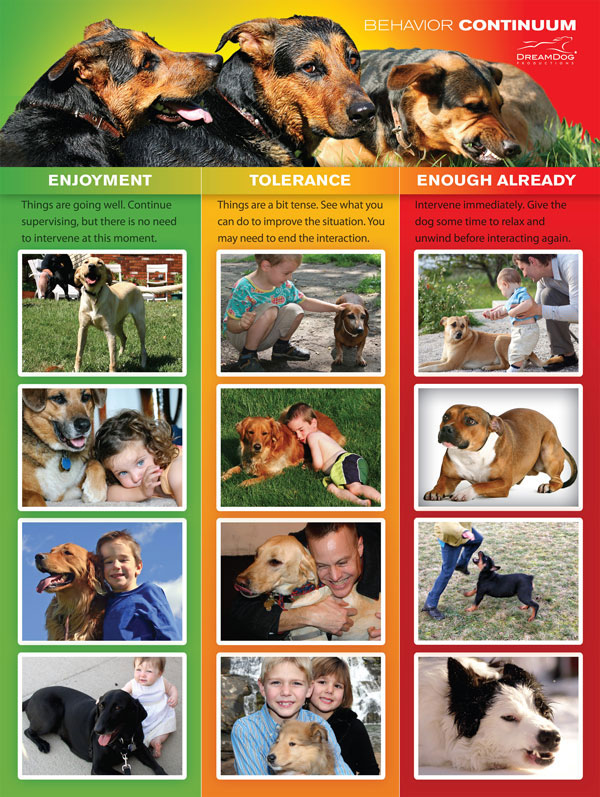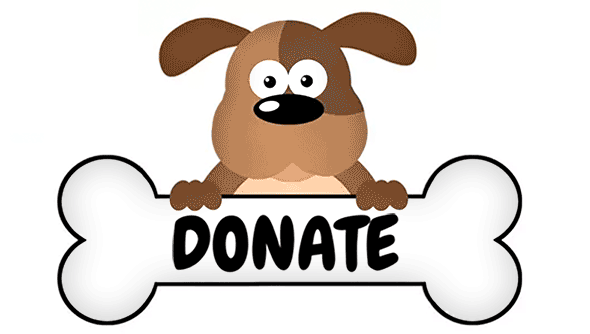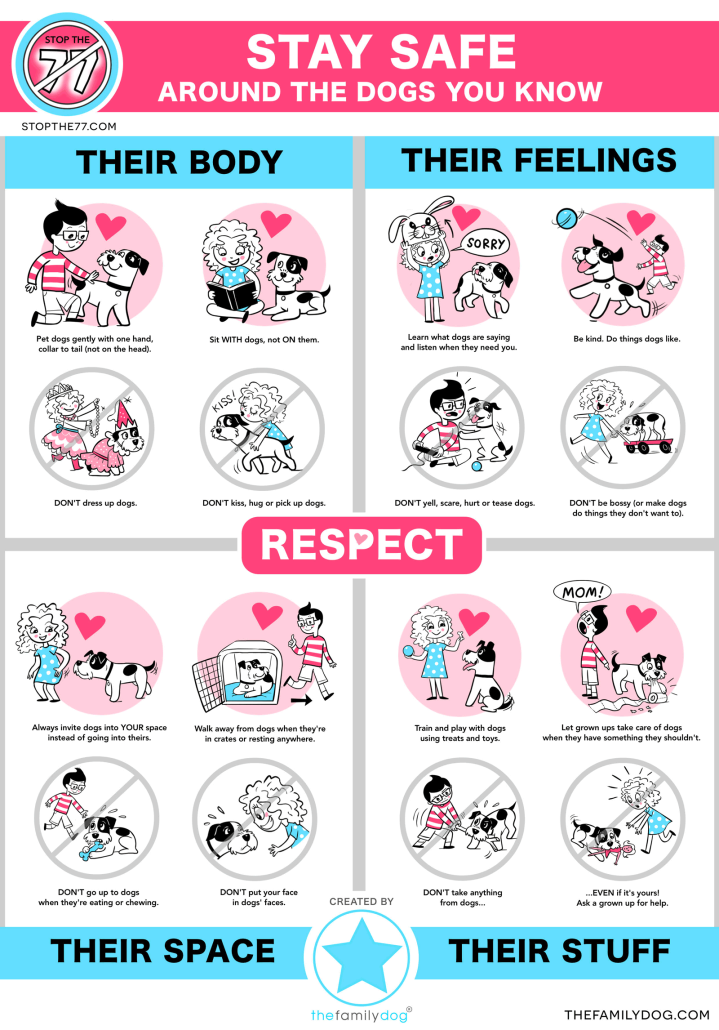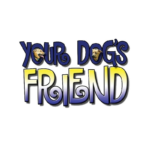Children & Dogs
Dogs and humans speak different languages, and nowhere is this difference more clear than when kids and dogs get together. Signs of affection from kids — hugging, kissing, playing dress-up, sharing a blanket — can make dogs feel threatened. Dogs also often feel unsafe around the high-pitched voices and quick, unpredictable movements that are so natural to children. Dogs express their discomfort through signals that people often don’t recognize or understand. This can lead to a bite or nip that is neither our child’s nor our dog’s fault, but rather our own.
If you’re a parent, you love your kids and your dog, and want them to become happy companions. If you’re a “pet parent” without kids in the home, you want your dog to develop good relationships with children who visit, as well as those you meet in public.
Even a “Good Dog” Can Bite
Head lowering or turning, a tucked tail, moving away, lip licking, shaking off (as if wet), yawning or a half-moon eye (white arc around the iris) are all messages from your dog that he is stressed and needs to get away. When we miss their signs of distress, our dogs may end up growling to let us know that they have had enough.
Punishing a growl won’t protect your child. Rather, it will teach your dog to bite without a growled warning!
Parents are typically surprised to learn that most dog bites to children occur when parents are in the same room. We don’t notice that what we think of as cute is stressful for our dogs. We miss the signs.
But even “good” dogs will bite if no one is helping them and they see no other way out. Supervise interactions and intervene early. Let your dog escape to a “safe” place before he feels a need to protect himself.
Conditioning is not a guarantee
Some parents have tried pulling tails, ears, and bumping into dogs to prepare them for children. Not only is this unfair to your dog, it also doesn’t guarantee that your dog will tolerate children doing the same. Your dog has a unique relationship with each person; so focus on building a good relationship between your dog and your child. Teach your dog to associate your child with good things happening by giving your dog special treats when your infant or toddler is around. Teach your school-age child how to gently offer a treat and make sure your children have activities of their own, even though your dog is in the same room.
Good intentions are not enough
Almost all children mean well when they’re with your dog, but that’s not enough. Your dog can still be unhappy when children do things that are uncomfortable for your dog – like hugging, kissing, patting the dog’s head, going into his crate, or lying down on him. At home and in public, help children who run up to your dog learn what your dog likes and how to read his signals. Encourage each child, one at a time, to pet your dog on his chest or under his chin, and then only if your dog approves. Teach them that if your dog backs away or looks away, it’s time for a nice good-bye. They may even be pleased that they have learned some “Doglish.”
Teens can be as tough as toddlers
Your field of vision has to grow as your child does. Even if your dog was fine around your baby, when that same child begins crawling, walking and falling, it’s a new ballgame. Young children and teens present their own set of dangers, like riding bikes, throwing balls, having friends over, and running around the house. Just because your teen has grown up with dogs and can reason (kind of) doesn’t mean that he won’t do mindless things around your dog. And when your children’s friends come over, it may be best to separate your dog from the chaos by putting him in his own space with a stuffed Kong or interactive toy before those friends arrive.
Supervision is critical
Supervision means more than being in the same room with your child and dog. Paying attention to what goes on, and letting your dog escape when he needs to, will help your child and dog learn how to enjoy each other. Children and dogs can build memories together that last a lifetime, but they can’t do it without your guidance and support.
Tolerance vs. Enjoyment
Your dog, especially if he’s mellow, may tolerate some of your child’s more rambunctious antics. But when your child chases, falls on, picks up, hugs or grabs your dog, most dogs don’t enjoy it. Unless your dog is enjoying, not just tolerating, the interaction with your child, it’s a good idea to separate the two. Likewise, when your child has had enough of your dog’s nipping, jumping or licking, give your child somewhere safe to go. Make sure that their time together is happy, so they can form a bond, and give them both a break before either your child is upset or your dog is stressed.
Enough Already
The following graphic is shown with the kind permission of its author Colleen Pelar. Notice the different body language in each column, and remember that if your dog is tolerating, rather than enjoying, your child at that moment, it’s time to help your dog escape before things escalate. Be safe, rather than sorry.

Key points to remember:
- Learn to read your dog’s stress signals. If your dog isn’t clearly enjoying your child at that moment, it’s time to intervene.
- Carefully supervise all play between your child and your dog. Just being in the same room with them isn’t enough.
- Recognize that when your dog growls, he is warning you, in the best way he knows how, that he is over-stressed and needs your help.
- Remember that the same dog that loved your baby may not be as comfortable when that same baby is a toddler, young child, or teenager.
- Keep in mind that sometimes, it’s best to put your dog in a separate area before your children’s friends arrive, so that your dog isn’t revved up by the loud noises and sudden, quick movements that ensue.
Resources for Children & Parents:
The webinar, The Truth About Kids & Dogs – what no one tells parents, was presented by the Family Dog in December, 2021. It is on Your Dog’s Friend YouTube channel at https://www.youtube.com/watch?v=SmnVFRaDR28&t=2s.
May I Pet Your Dog? – The How-to Guide for Kids Meeting Dogs (and Dogs Meeting Kids) by Stephanie Calmenson teaches children in pre-school through second grade when and how to approach a dog.
The website www.LivingWithKidsandDogs.com offers all sorts of useful information for parents, as well as a link to order the books, Living With Kids and Dogs…Without Losing Your Mind and Puppy Training for Kids by Colleen Pelar.
There are articles and resources for expectant parents and parents of babies and toddlers at www.FamilyPaws.com, home to both Dogs & Storks and Dog & Baby Connection. Family Paws also runs a Dog and Baby Support hotline at 1-877-247-3407.
At www.thefamilydog.com, you can find tips, videos, and an online training program for the entire family, with a special section just for kids. Watch their important video for children, “Stop the 77“.
Still Need Help?
Contact Your Dog’s Friend at [email protected] or (301)983-5913 for advice and referrals or check out our list of recommended trainers and behaviorists.
Your Dog’s Friend is a nonprofit 501(c)(3) organization working to improve dogs’ lives, reduce problem behaviors, and keep dogs out of shelters, by educating and supporting their humans.
This material is not intended to be a substitute for professional help when dealing with dogs with intense or potentially dangerous behavior issues. Consult a positive reinforcement trainer or veterinary behaviorist for professional assessment, guidance, and support.





